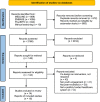Youth engagement in mental health research: A systematic review
- PMID: 36385452
- PMCID: PMC9854331
- DOI: 10.1111/hex.13650
Youth engagement in mental health research: A systematic review
Abstract
Introduction: Patient engagement in youth mental health research has the potential to inform research on the interventions, services and policies that will benefit youth. At present, there is little evidence to guide mental health researchers on youth engagement. This systematic review aims to describe the impacts of youth engagement on mental health research and to summarize youth engagement in mental health research.
Methods: We searched the following databases: MEDLINE, EMBASE and PsycINFO, using a combination of subject headings, keywords and synonyms for the concepts 'patient engagement', 'youth' and 'mental health'. Articles that described engaging youth in mental health research were included. Two reviewers performed the study selection. Study characteristics, research activities performed by youth, impacts of youth engagement, challenges, and facilitators to engagement and recommendations for youth engagement described by authors were extracted. Quality appraisal involved determining the level of engagement of youth and the stage(s) of research where youth were involved.
Results: The database search returned 2836 citations, 151 full-text articles were screened and 16 articles, representing 14 studies, were selected for inclusion. Youth were involved at nearly all stages of the research cycle, in either advisory or co-production roles. Youth engagement impacts included enhancing relevant research findings, data collection and analysis and dissemination to academic and stakeholder audiences. Both youth and academic researchers reported personal development across many domains. One negative impact reported was the increase in funding and resources needed for engagement. We produced a list of 35 recommendations under the headings of training, youth researcher composition, strategy, expectations, relationships, meeting approaches and engagement conditions.
Conclusions: This study provides an understanding of the impacts and recommendations of youth engagement in mental health research. The findings from this study may encourage researchers to engage youth in their mental health research and support youth engagement in funding applications.
Patient and public contribution: We consulted three youths with experience being engaged in mental health research about the review findings and the discussion. One youth designed a visual representation of the results and provided feedback on the manuscript. All youth's input informed the way the findings were presented and the focus of the discussion.
Keywords: co-design; community-based research; mental health; mental health services; patient and public involvement; patient engagement; youth engagement.
© 2022 The Authors. Health Expectations published by John Wiley & Sons Ltd.
Conflict of interest statement
The authors declare no conflict of interest.
Figures


Similar articles
-
Benefits, barriers and recommendations for youth engagement in health research: combining evidence-based and youth perspectives.Res Involv Engagem. 2024 Sep 2;10(1):92. doi: 10.1186/s40900-024-00607-w. Res Involv Engagem. 2024. PMID: 39223602 Free PMC article. Review.
-
Beyond the black stump: rapid reviews of health research issues affecting regional, rural and remote Australia.Med J Aust. 2020 Dec;213 Suppl 11:S3-S32.e1. doi: 10.5694/mja2.50881. Med J Aust. 2020. PMID: 33314144
-
Recovery schools for improving behavioral and academic outcomes among students in recovery from substance use disorders: a systematic review.Campbell Syst Rev. 2018 Oct 4;14(1):1-86. doi: 10.4073/csr.2018.9. eCollection 2018. Campbell Syst Rev. 2018. PMID: 37131375 Free PMC article.
-
Impact of summer programmes on the outcomes of disadvantaged or 'at risk' young people: A systematic review.Campbell Syst Rev. 2024 Jun 13;20(2):e1406. doi: 10.1002/cl2.1406. eCollection 2024 Jun. Campbell Syst Rev. 2024. PMID: 38873396 Free PMC article. Review.
-
Understanding Mobile Health and Youth Mental Health: Scoping Review.JMIR Mhealth Uhealth. 2023 Jun 16;11:e44951. doi: 10.2196/44951. JMIR Mhealth Uhealth. 2023. PMID: 37220197 Free PMC article.
Cited by
-
Benefits, barriers and recommendations for youth engagement in health research: combining evidence-based and youth perspectives.Res Involv Engagem. 2024 Sep 2;10(1):92. doi: 10.1186/s40900-024-00607-w. Res Involv Engagem. 2024. PMID: 39223602 Free PMC article. Review.
-
Discussing the gaps in the science and practice of lived experience engagement in mental health and substance use research: results of knowledge mobilization activities.Res Involv Engagem. 2024 Feb 10;10(1):23. doi: 10.1186/s40900-024-00554-6. Res Involv Engagem. 2024. PMID: 38341548 Free PMC article.
-
Collaborating With Young People: Identifying the Barriers and Facilitators in Co-Designed Research.Health Expect. 2025 Jun;28(3):e70308. doi: 10.1111/hex.70308. Health Expect. 2025. PMID: 40432242 Free PMC article. Review.
-
How are patient partners involved in health service research? A scoping review of reviews.Res Involv Engagem. 2025 Jul 8;11(1):78. doi: 10.1186/s40900-025-00755-7. Res Involv Engagem. 2025. PMID: 40629409 Free PMC article. Review.
-
An Application of Evidence-Based Approaches to Engage Young People in the Design of a Global Mental Health Databank.Health Expect. 2024 Oct;27(5):e14172. doi: 10.1111/hex.14172. Health Expect. 2024. PMID: 39243177 Free PMC article.
References
-
- Mental Health Commission of Canada. Children and Youth. Mental Health Commission of Canada; 2013. https://www.mentalhealthcommission.ca/sites/default/files/2016-06/Invest...
-
- Statistics Canada. Table 13‐10‐0763‐01 Health Characteristics of Children and Youth Aged 1 to 17 Years, Canadian Health Survey on Children and Youth 2019. Statistics Canada; 2019.
-
- Canadian Institute for Health Information. Child and Youth Mental Health in Canada [Infographic]. Canadian Institute for Health Information; 2020.
Publication types
MeSH terms
Grants and funding
LinkOut - more resources
Full Text Sources
Medical

